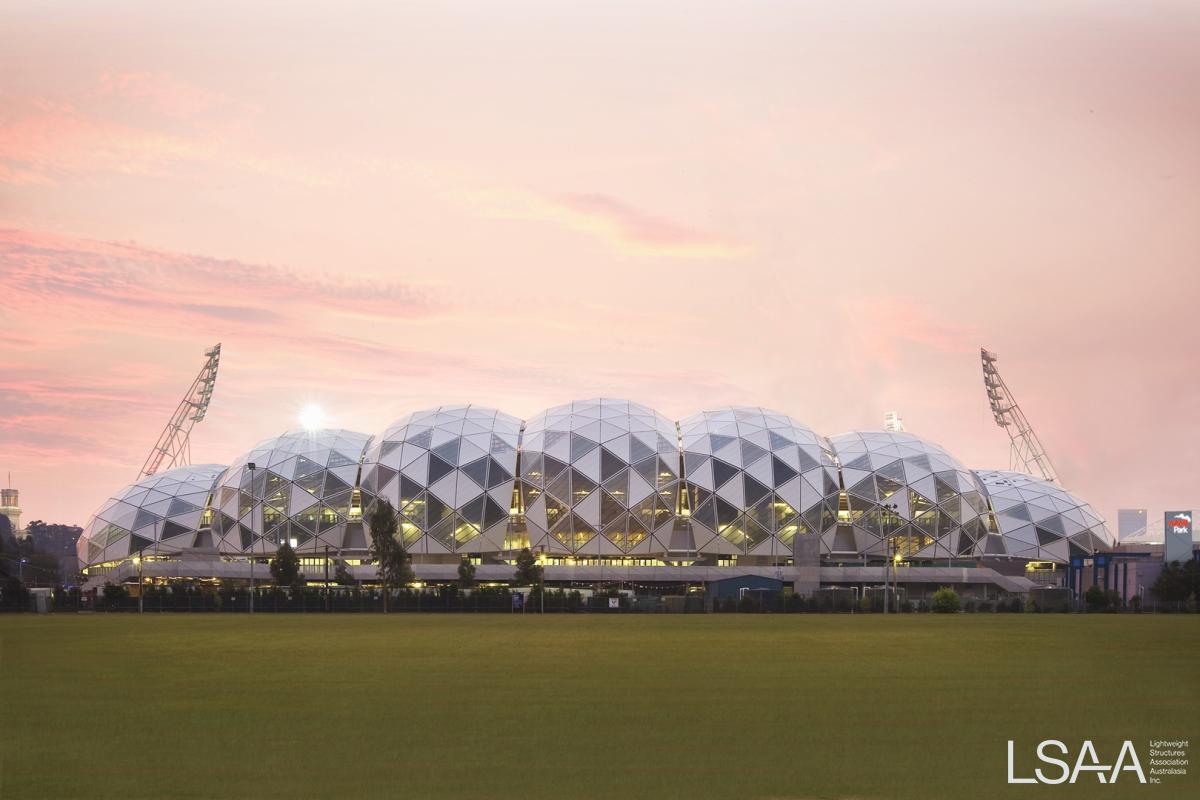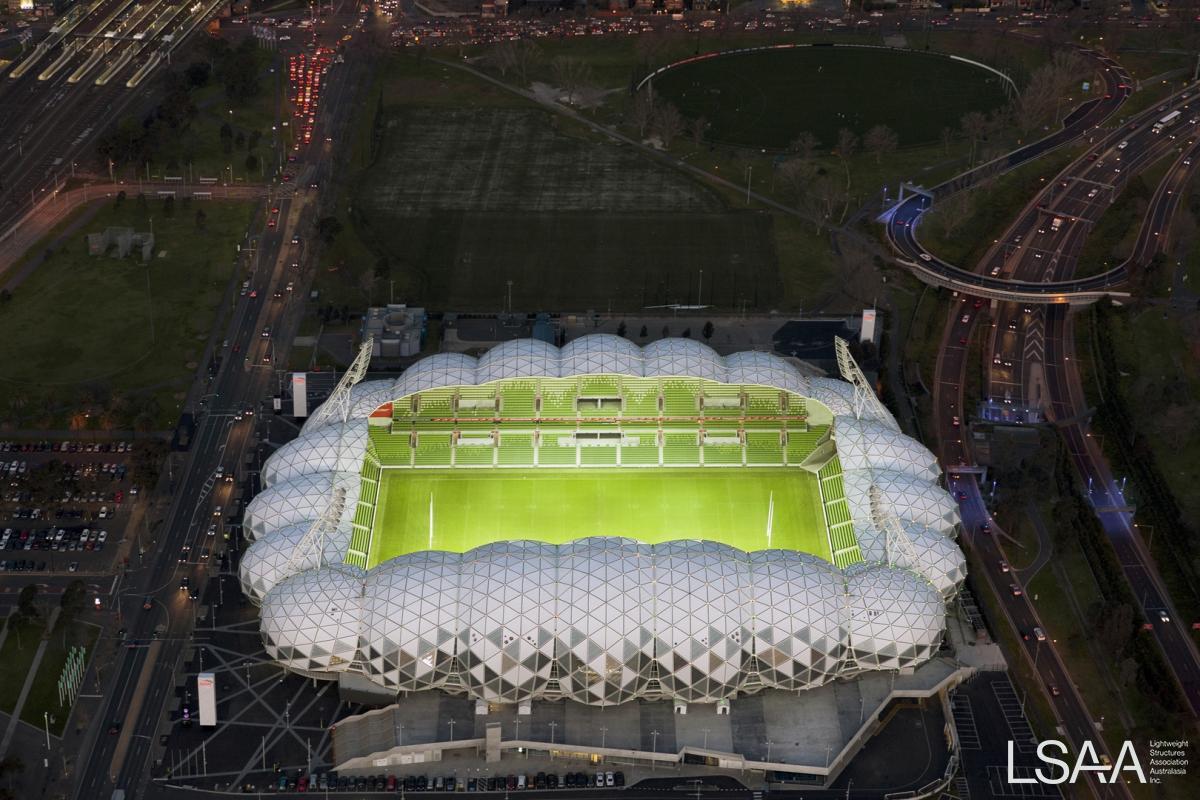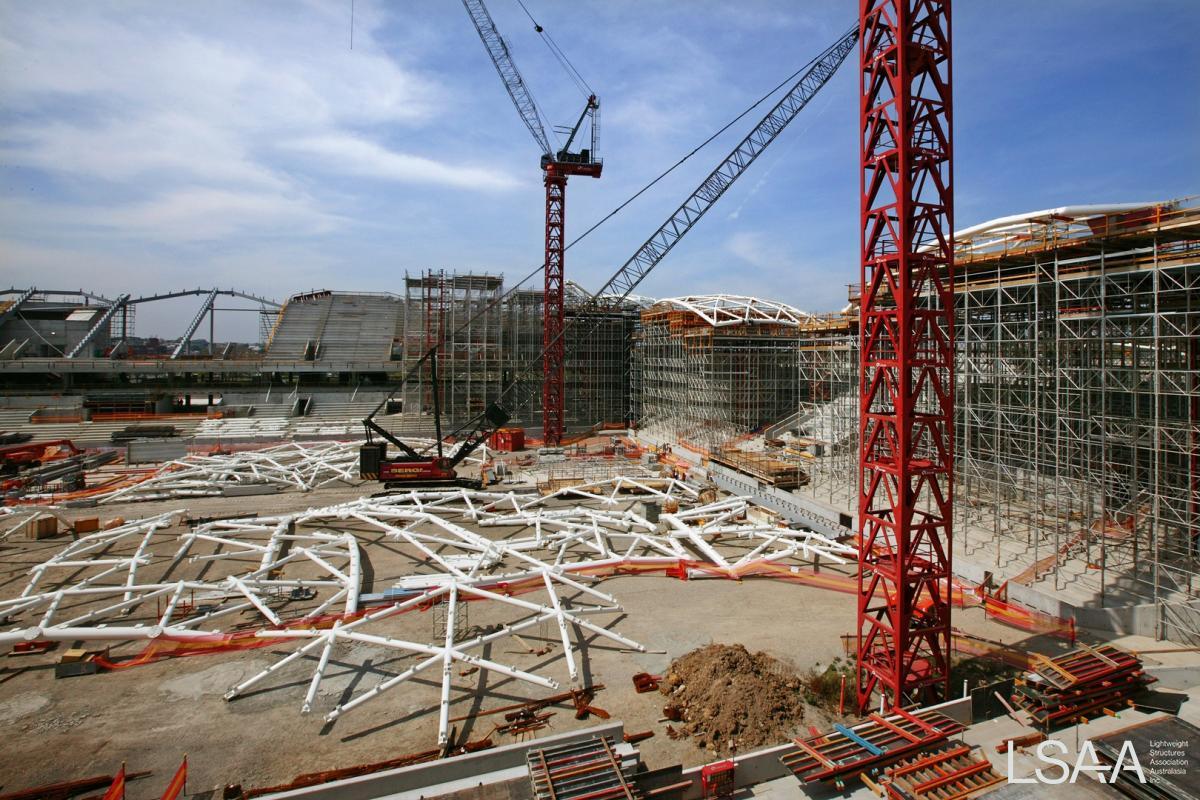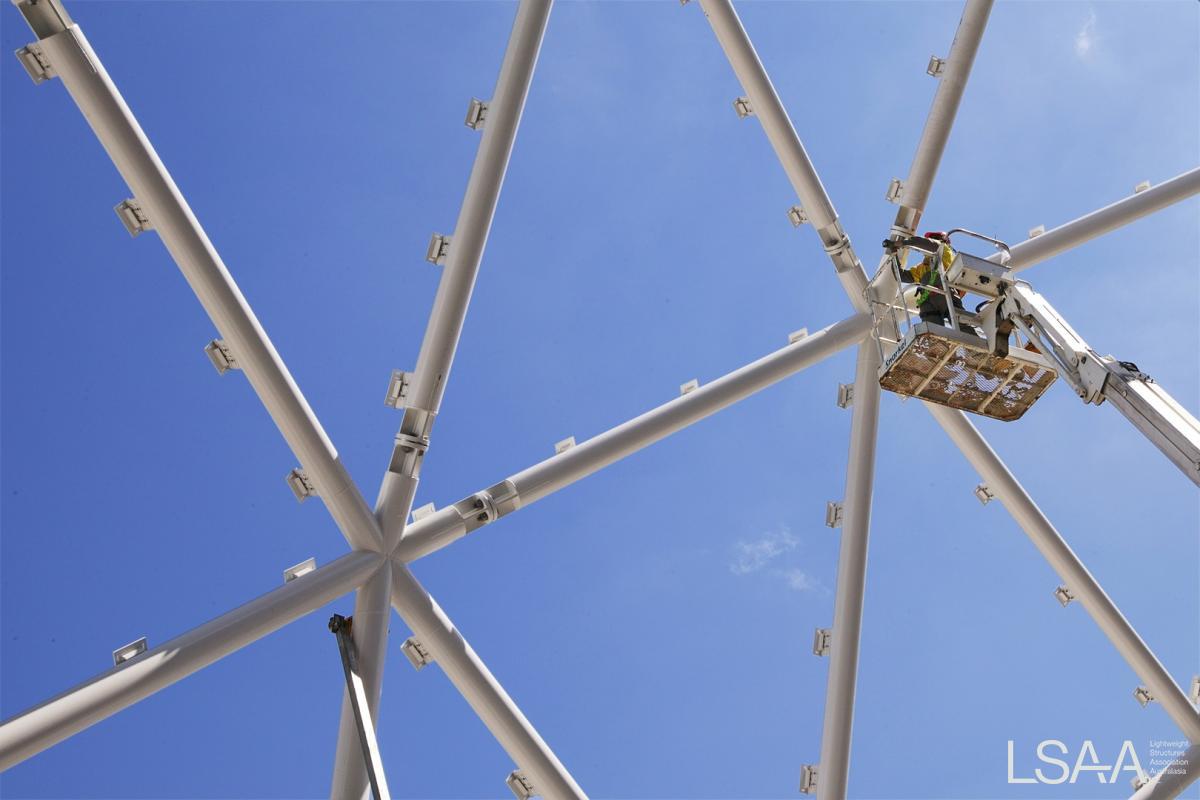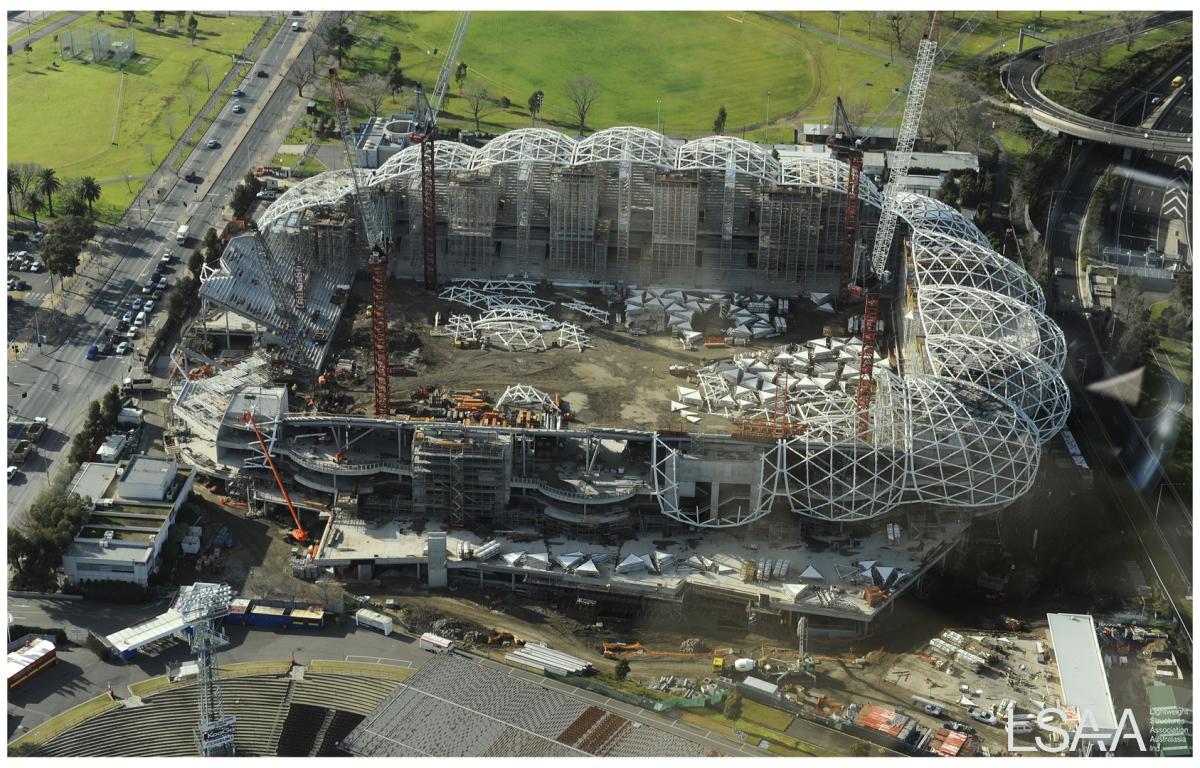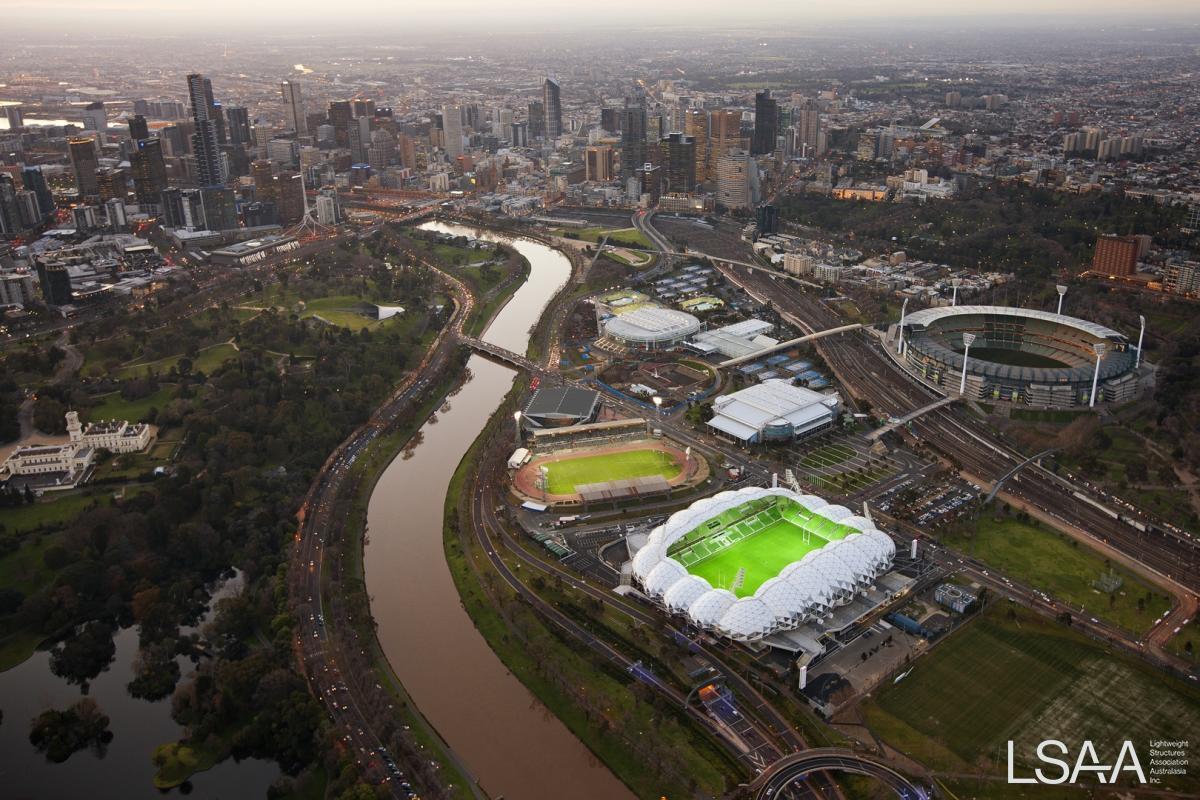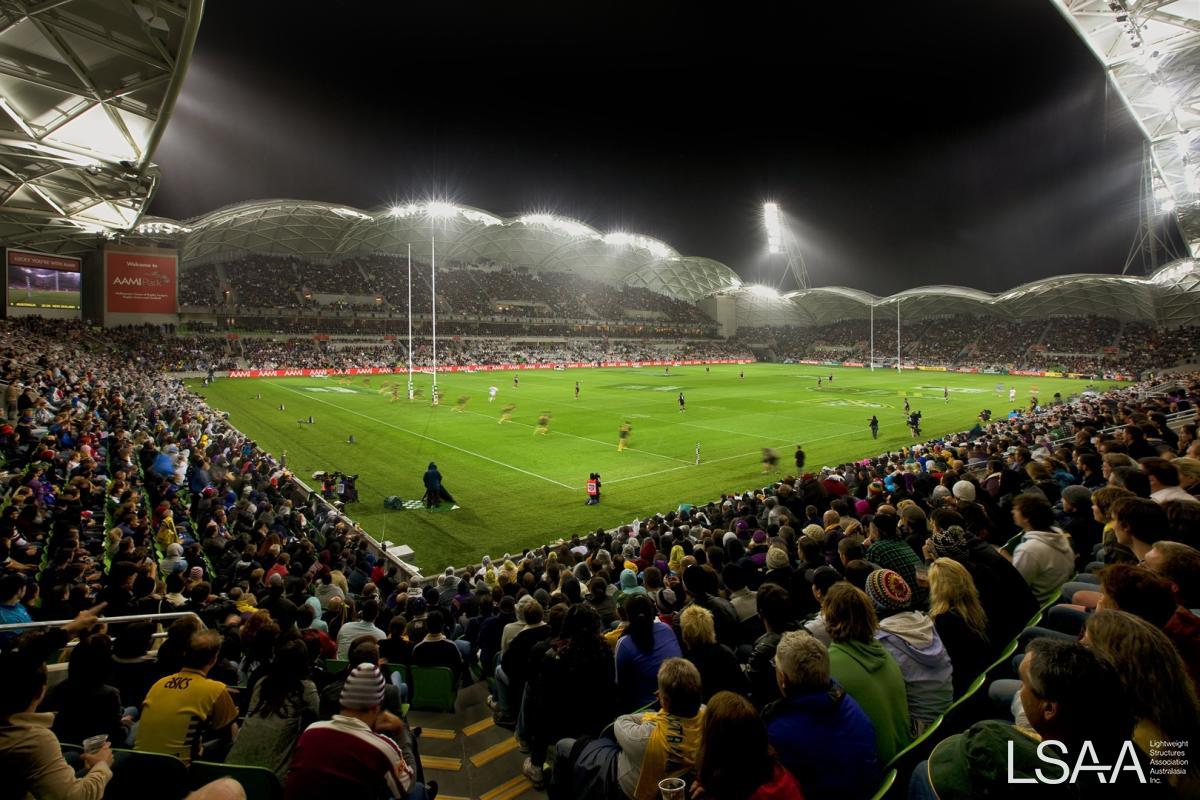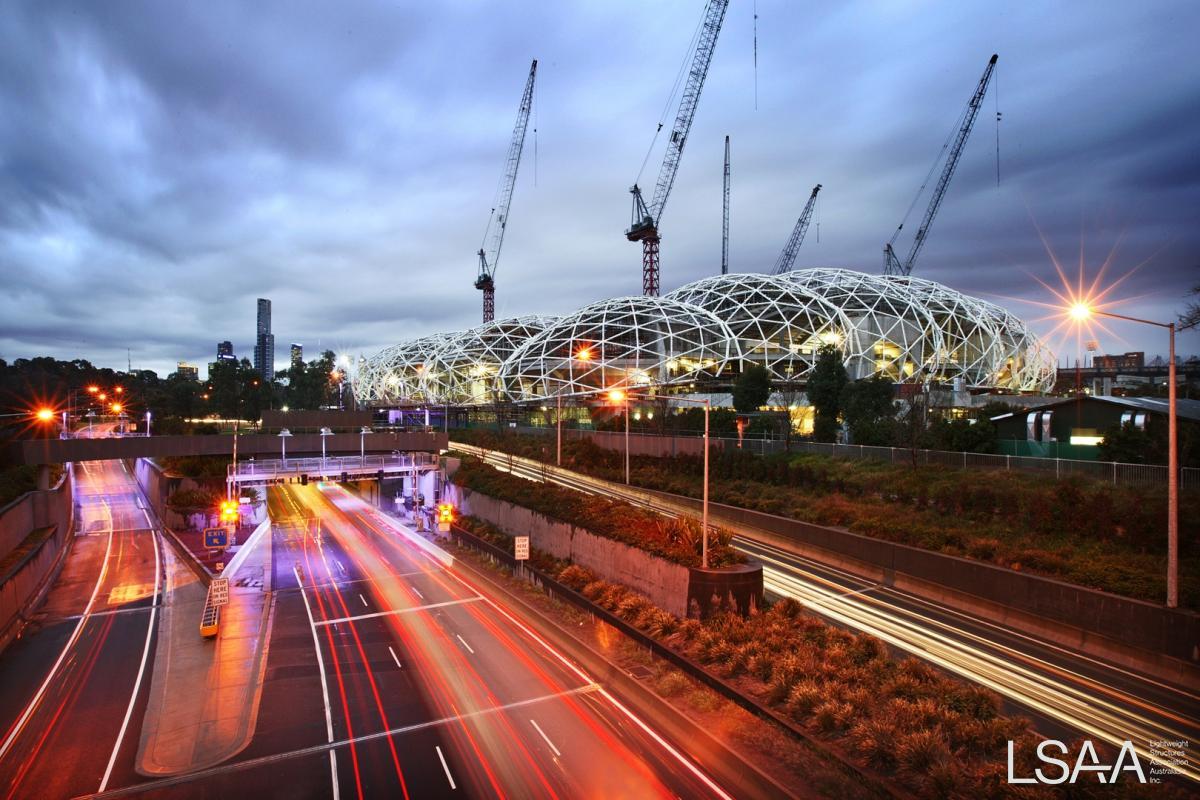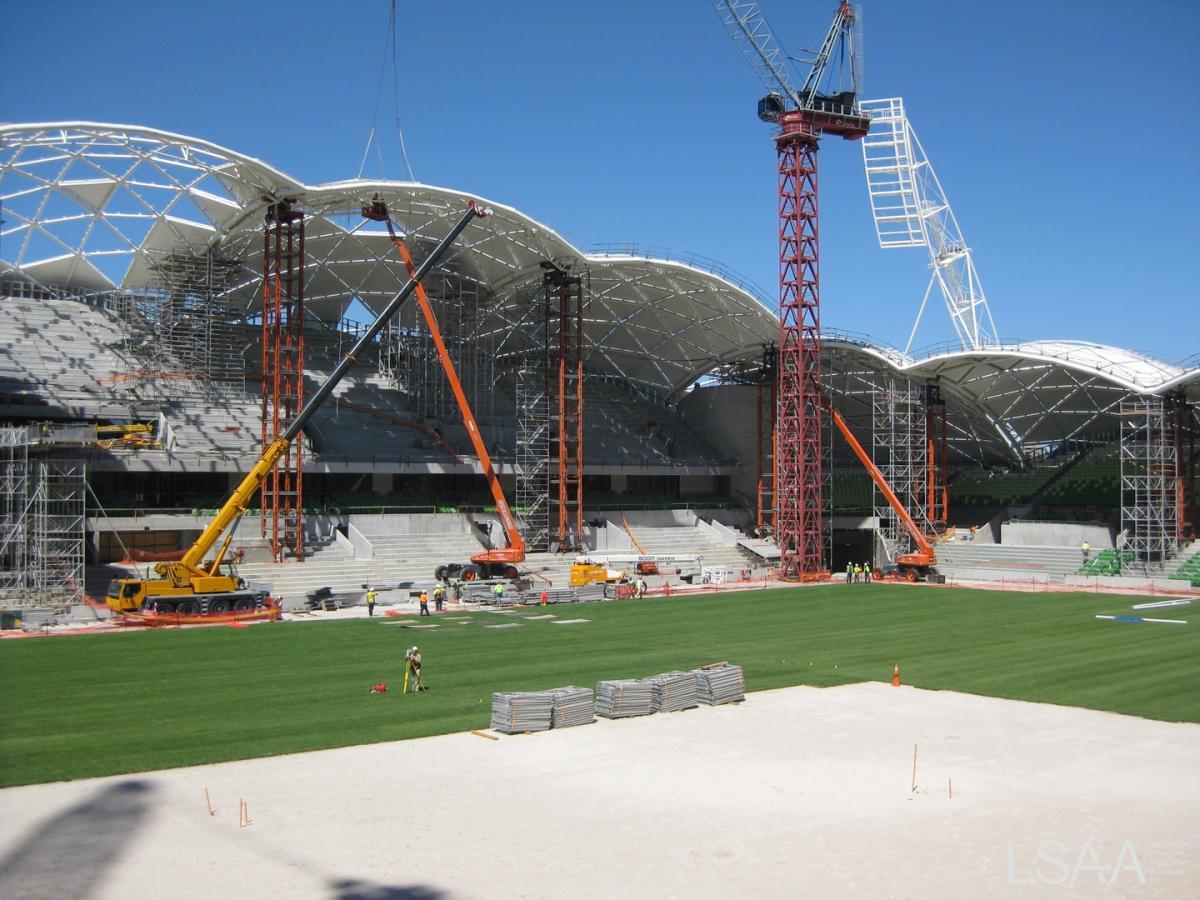Project Entry in LSAA 2011 Design Awards (Cat 6, 6983)
APPLICATION OF PROJECT
AAMI Park is Melbourne’s first purpose built venue for football (soccer), rugby league and rugby union. The 30,000-plus seat stadium offers a world class arena and playing surface for all three codes with an unparalleled spectator experience in terms of sightlines, atmosphere and amenity
PROJECT DESCRIPTION
AAMI Park, with its iconic bio-frame roof, fills a gap in Melbourne’s renowned suite of sporting facilities and increases the city’s ability to attract national and international events.
Home to the Victory, Hearts, Storm, Rebels and Melbourne Football Club teams, the stadium also features a sports medicine centre, elite training facility and administration complex, making it a true sports campus for Melbourne.
AAMI Park provides a strong foundation for football and the league and union codes to develop their fan base, and cements Melbourne’s claim as Australia’s – if not the world’s – sporting capital.
AAMI Park’s world class playing pitch and outstanding player facilities make it one of the best grounds to play on. In fact, AAMI Park is one of the few stadiums in the world to house four different sporting codes.
Moreover, the stadium provides these sporting codes with a world class arena and excellent playing surface that increase Victoria’s ability to attract both national and international events, while adding to Victoria’s economic growth and Melbourne’s claim as Australia’s sporting capital.
AAMIPark’s unique roof has a beautiful simplicity, completely embodying a ‘less is more’ approach in design and construction. As a distinctive addition to Melbourne’s civic architecture, AAMIPark continues the strong architectural lineage of Melbourne and Olympic Parks evidenced since 1956. Importantly, it represents a move forward by the city to provide residents and visitors with an international class facility that embodies a pioneering approach to public architecture, and in turn, public life.
Features include:
-
capacity for over 30,000 patrons
-
a unique bio-frame roof featuring a spectacular LED lighting feature which is a public art installation
-
a 136m x 82m rectangular pitch – accommodating rugby league, rugby union and football
-
a sports campus including around 800sqm of elite training facilities incorporating a gymnasium and internal athletics areas
-
a four-lane 25m lap pool with additional player recovery facilities
-
commercial offices for sports administration for Melbourne Storm, the Victorian Rugby Union, the Melbourne Football Club, Melbourne Victory, the Victorian Olympic Council and the Melbourne and& Olympic Parks Trust
-
sports medicine facilities including a radiology clinic (Imaging@Olympic Park) and the Olympic Park Sports Medicine Centre
-
twenty-four corporate suites with exclusive internal and external seating
-
a dining room with capacity for over 1,000 people
-
merchandising facilities, 14 food and beverage outlets and 14 bars
-
a public café/bar and merchandise outlet on Olympic Boulevard.
DESIGN / FABRICATION / INSTALLATION BRIEF
The client brief was to deliver a stadium that would achieve world standards and be extraordinary in terms of structure, atmosphere and spectator experience.
The project’s objectives were outlined early in the planning stages and provided a clear set of goals for the entire project team to work to.
The objectives were:
-
to deliver a high quality rectangular pitch stadium with a minimum seating capacity of 30,000, that complements the world class Sports and Entertainment Precinct and the surrounding parkland
-
to provide equity of access to all users, promoting the use of public transport, existing facilities and infrastructure where possible
-
to provide a facility that showcases the viewing experience for rugby and football codes and which provides high quality training and sports development facilities
-
to provide a facility within agreed costs
-
to integrate ecologically sustainable development (ESD) features into the project through good design and innovation, incorporating the need for future expansion of the stadium and development of the precinct
-
to retain and protect the project design elements endorsed by Government and Melbourne & Olympic Parks Trust (MOPT) and that drive MOPT’s funding contribution, including operational efficiencies through design
-
to aim to design a facility that minimises operating costs for the end user and maximises revenue opportunities.
Lightweight bioframe roof
The construction of AAMI Park represented the next generation of stadium design, being both innovative and daring. The true complexity of AAMI Park was evident in the stadium’s ground breaking design. At the heart of this design is a self supporting, lightweight bio-frame roof.
The bio-frame roof (so named for its ability to support various and evolving functions) is a lightweight steel design based on the structural efficiencies of the Buckminster Fuller geodesic dome, using 50 per cent less steel than an equivalent traditional dipped cantilever design. Given the high embodied energy of steel, its minimal use in the stadium also represents a significant environmental benefit. Appendix A provides a comparison between this and other leading stadia in terms of the tonnage of steel used and the resultant embodied energy per seat.
Without any superficial elements, every component of the bio-frame roof serves multiple purposes, ensuring that an absolute minimum of material is used in the building.
The unique roof cladding system ensures heat gain and loss is optimally managed with minimal impact upon views. Each glass and metal panel is designed to suit their specific location, and allows various levels of sunlight penetration and views into and out of the stadium. In addition, the shape of the roof allows maximum sunlight penetration to the pitch while encouraging gentle air movement on to the ground, which is critical to the health of the turf and subsequently the experience of the players.
The curvature of the internal surface of the roof is used to reflect light to the seating bowl providing a more uniform and efficient bowl lighting system. The cladding on the external nodes of the roof is used to reticulate the electrical services for the unique public art installation which uses digitally controlled, individually programmed LED lights which consume around one tenth the energy of an equivalent conventional feature lighting system.
AAMI Park contributes to a sustainable future by providing examples of the ways in which clever design, engineering and building practice can minimise the amount of materials required for a building. The stadium structure and design process exemplify a ‘less is more’ approach, balancing form and function to create a structurally and resource efficient building.
Quality
AAMI Park is a success in both its form and function. The project not only had to look good but also had to meet its objectives as an operating sports stadium. The design itself is a unifying element because everyone involved with the project aspired to make what seemed an impossible dream manifest itself into a world class stadium. The design included three main focus points – the roof, the seats and the turf – and the ultimate quality of these elements were of great importance to the project team.
Build quality
Major Projects Victoria (MPV) deployed a process jointly with the builder, the design team and a third party reviewer for monitoring and approving design and construction throughout the project. The monitoring of build quality was straightforward because of the open and transparent process implemented on the project. This process encouraged the team to challenge each other; for example, the process of samples and prototypes being submitted for approval could be likened to a ‘journey’, which all parties participated and genuinely engaged in, providing a high quality outcome which generally exceeded specification requirements.
A key outcome of this process was the LED roof lighting, which was originally not part of the scope and which would normally be considered too risky to even consider part way through construction. The focus on achieving the shared objectives of build quality and project objectives in an efficient manner was demonstrated in this and many other instances.
Design quality
With a team focused on best-for-project outcomes, the process yielded benefits to the client and the builder, and the design in fact responds very closely to the way tenants and the operator want to use the facility. The process undertaken by MPV to understand, interpret and document the requirements of the venue operator and the anchor tenants was critical in the early stages of the project.
The true complexity of AAMI Park was evident in the stadium’s ground breaking design, at the heart of which is the self supporting bio-frame roof. The construction of AAMI Park represented the next generation of stadium design, being both innovative and daring.
Further, this would be the first time a geodesic dome roof would be attempted for a sports stadium anywhere in the world, and the design would require a flexible and collaborative project team who during construction would remain true to this ground breaking and complex design.
As well as the inherent structural efficiencies of the bio-frame, the geometry of the roof and the curvature of the shells were used to benefit the project, creating a totally integrated form and function.
Light is reflected off the internal faces of each shell to ensure that a uniform distribution of indirect light is provided to the seating bowl. This has the benefit of ensuring patron comfort without the need for large numbers of light poles. It also means there is simplified access in terms of changing light globes because the lights are mounted on the same lighting truss as the sports lights.
The geometry of the roof and the overall profile not only considers where patrons most prefer sitting, but also orientates the lower shells at the north and south ends to allow sunlight and airflow to ensure the pitch is always healthy.
In summary, the roof design is a series of shells that provide support through the combined action of shell, cantilever, and overall arching across the front edge.
The roof design is based on a geometry set out around two key points of connection to the bowl frame – the base of the groin anchor and at the rear of the upper raker. These two locations require specific consideration of their set out and construction, which was undertaken during the detailed design and construction phase.
Australian Standards apply to all individual elements in the roof shell. With respect to the roof as a whole, Australian Standards needed to be interpreted to non-generic forms of steel fabrication and erection: because the roof is a shell form more analogous to space frame construction, a similar approach to tolerances was required.
The design strategy was to provide tolerance between the shells in the groin splice, at the base of the columns supporting the rakers, and at the raker connection.
The ability of these tolerance allowances is impacted by the methodology of construction. In particular, the decision to erect piece-small and insitu versus pre-assembly and lifting of large elements changed the tolerances required at the raker and between individual elements.
The groin base anchors are set on tri-columns. The geometry of these tri-columns evolved during the detailed design phase to allow greater form repetition.
The design detailing of the groin base anchor structure also evolved in close consultation between the design team and the contractor, to suit preferred methodology and program.
The tonnage of steel of the roof was affected by the issues of resolution of the wind loads, erection methodology, and finalisation of the cladding design.
Spectator experience
AAMI Park boasts an unparalleled spectator experience that places fans up close to the action.
A main principle driving the form of the stadium was the desire to provide the perfect seating bowl, with most seats positioned in the preferred east and west flanks to provide excellent sightlines and proximity to the action. The design provides extensive seat coverage and excellent spectator sight lines with uninterrupted views. Acoustically engineered for sporting events, the stadium provides an atmosphere to complement the action that takes place on the field, dramatising the spatial and sensory experience for the benefit of players and spectators.
The spaces under the seating plats are used to provide tenancy spaces for stadium suppliers and sports administration offices for tenants. They also provides a separate space so that circulation of food, beverage, waste handling, security and other stadium functions can occur efficiently and without interacting with the patron zones.
Completed in May 2010, AAMI Park has met and exceeded the client’s objectives and vision for the project. In testimony to its success, the stadium has since been recognised with 16 industry awards.
Ecologically sustainable development
The new stadium is an innovative and environmentally conscious sporting facility. Sustainable measures are integrated throughout the overall stadium design, from the ground up, and include:
-
a sustainable water saving roof drainage system, where rainwater is collected from the roof structure and stored in the stadium for use in seating terrace wash‐down, toilet flushing and for watering the stadium’s turf. Excess water collected is connected to the new Olympic Park precinct water system
-
energy efficient lighting through the roof design, and a unique zoned lighting system
-
the provision of natural ventilation which utilises the stadium’s facade
-
a cutting‐edge bio-frame design with a geodesic dome roof which substantially covers the seating area. This design uses 50 per cent less steel than a typical stadium roof of the same size, and enables better use of internal space
-
low embodied energy hollow core concrete slabs
-
an integrated waste management and recycling system
-
low water‐use fittings in corporate boxes, toilets, kitchens and bars
-
LED lights, a feature of the roof, which use 10 per cent of the power of a floodlit surface of an equivalent size
This stadium represents the next generation of structurally efficient design, and sets a new benchmark for other stadium projects around the world. It is a clear example of the value of integrated design leading to outcomes which are inherently sustainable.
STRUCTURAL SYSTEMS
In keeping with the client’s brief, the stadium roof concept developed by Arup and Cox Architecture provides a frame structure that requires 50 per cent less steel than typical stadium roofs of the same size. Given the high embodied energy of steel, its minimal use in the stadium also represents a significant environmental benefit. Attachment A provides a comparison between this and other leading stadia in terms of the tonnage of steel used and the resultant embodied energy per seat.
The design provides extensive seat coverage and excellent spectator sight lines with uninterrupted views. The unique design was inspired by principles of shell theory, extrapolated from the geodesic domes of Buckminster Fuller. The design utilises state of the art structural engineering and technology to provide value, excellence, innovation, sustainability and construction benefits to the project.
Each of the roof’s shells uses a combination of three structural systems to produce the lightweight structure. This level of efficiency and the subsequent iconic form of the stadium showcases the possibilities of technology and a collaborative approach between architect, engineer and builder. The design team worked within a virtual 3D environment, from concept stage through to construction. Parametric modelling was used to define the roof structure because of its ability to test alternative geometric configurations to optimise the structural form, and to accommodate the final preset geometry for fabrication and construction purposes.
AAMI Park’s design allowed shells to be fabricated off site in transportable sized sections, and to be erected on site on a temporary support system. Steelwork could be fabricated off site, allowing works on the concrete bowl structure to progress and shortening the construction critical path time.
The design, consisting of 20 individual (interconnected) shells allowed the contractor to appoint three separate fabricators, therefore reducing fabrication and overall construction time.
The design also provided some repetition to simplify the construction process. Each of the four quadrants is symmetrical, allowing repetition of cladding panel shapes and sizes.
Without any superficial or decorative elements within the design, every component of the roof serves multiple purposes, ensuring an absolute minimum of material was used. This level of efficiency and the subsequent classic form of the stadium showcases the possibilities of technology and a collaborative approach between architect, engineer and builder. Such precision of the steel roof structure and its connection to the concrete bowl has required close coordination between all design, fabrication and assembly teams.
The other unique challenge presented to the team was the complexity of the site, with the Domain Tunnel at the rear of the site and the Burnley Tunnel running below the project. The design team closely investigated best possible foundation support structure to ensure no effect on the existing infrastructure.
Parametric modelling (see diagram below) was used to define the roof structure because of its ability to test alternative geometric configurations to optimise the structural form, and to accommodate the final preset geometry for fabrication and construction purposes.
AAMI Park’s design allowed the roof’s shells to be fabricated off site in transportable sized sections, and to be erected on site on a temporary support system. Steelwork could be fabricated off site, allowing works on the concrete bowl structure to progress, and shortening the construction critical path time.
Adding to the roof’s fantastic curvature is the 1,500 low power-use LED lights omitting a series of breathtaking lighting schemes each night, designed by two local artists commissioned by the project team. Not only do they look fantastic, the LED lights also light the outside of the stadium in an environmentally considerate way.
Design loadings
The stadium roof was designed to support sandwich and glass panels fixed directly to the steel structure without the need for secondary steel framing, further reducing the amount of steel used and time taken to erect the roof.
The roof was also designed to support sports lighting and speakers at the leading edge of the east and west stands. Light towers, which provide necessary lighting for night events, are mounted on the roof at each corner. Being the strongest part of the roof structure, this was able to be accomplished with little extra steel.
The major loads acting on the roof structure are wind loads. Wind tunnel testing was used to determine the base simultaneous wind pressures. Time spectral analysis techniques, where time history pressure measurements are applied to the roof structure, were used to determine the enhancement due to dynamic behaviour. Thus the wind loads were determined by a combination of wind tunnel testing and post analysis work.
Geometry
While the geometry provides an exciting architectural form, it is primarily driven by the desire for structural efficiency. The roof’s shells use a combination of three structural systems to produce the lightweight structure. These include arch or centenary action at the leading edge, cantilever action of the groins, and shell action.
Parametric modelling was used to define the roof structure because of its ability to test alternative geometric configurations to optimise the structural form, and to accommodate the final preset geometry for fabrication and construction purposes.
Optimising the roof form was able to be accomplished by varying the model geometry, importing it into the structural package and checking the effects on structural efficiency. Geometry changes such as overall rise of leading edge and rise between groins were also able to be tested.
To enhance conditions for turf health, the leading edge of the north and south roofs were dipped to allow better sunshine and air movement over the pitch, which is an aid to good turf health.
Ground conditions
The site surface geology comprised Quaternary Age alluvial deposits and the newer volcanic (basalt) formations. The basalt over the site was extremely variable, with ranges in depth from six to seven metres. Depths to the basalt likewise varied and were found to be between one and seven metres from the surface.
The Burnley Tunnel was located at a depth of 20 metres at the northern end of the site.
As the rock was determined to be of sound quality the decision was made to support the stadium on this rock. This avoided the need to penetrate the rock with 25 metre-plus long piles. A combination of pad footings and bored piers ranging in diameter from 600 to 1200 mm was used to support the stadium structure.
MATERIALS
The following materials were used in the construction of AAMI Park:
Suspended slab construction
|
Product |
Selected for |
|
Hollowcore for slab construction |
Speed of construction |
|
Insitu concrete for slab, walls and columns |
Contractor preference/recommendation |
Concrete seating tiers
|
Product |
Selected for |
|
Precast plats |
Speed of construction and strength |
|
Steel structure for plat support |
Strength, visual appeal and speed of construction |
Shell structure
|
Product |
Selected for |
|
273 diameter CHS* varying thickness grade 350MPa generally |
Strength and visual appeal |
|
500 diameter CHS* varying thickness grade 350MPa edges |
Strength and visual appeal |
*Circular Hollow Sections
Shell cladding
|
Product |
Selected for |
|
ThyssenKrupp Pladur ® profiled metal sheeting with PVDF- Kynar 500 coating |
Strength visual appeal and durability |
|
16 millimetre laminated toughened glass |
Strength and visual appeal |
FABRICATION
The true complexity of AAMI Park was evident in the stadium’s ground breaking design centred on its self supporting, bio-frame roof. The construction of AAMI Park not only represented the next generation of stadium design, being both innovative and daring; it was also the first time that a geodesic dome roof would be attempted for a sports stadium anywhere in the world.
The bio-frame roof itself is a lightweight steel design based on the structural efficiencies of the Buckminster Fuller geodesic dome and inspired by shell theory. The roof also offered the promise of using 50 per cent less steel than an equivalent traditional cantilever design.
The roof design employed state of the art structural engineering and technology to provide value, excellence, innovation, sustainability and construction benefits. Each of the roof’s three dimensional shells uses a combination of three structural systems to produce the lightweight structure.
This level of efficiency and the subsequent iconic form of the stadium showcase the possibilities of technology and a collaborative approach between architect, engineer and builder. The design team worked within a virtual 3D environment, from the concept stage through to construction. This allowed the builder to undertake shop drawings directly from the design model with significantly improved accuracy.
Fabrication techniques
The self supporting roof frame was constructed from large structural segments made from lightweight steel produced off site from three different fabricators. These were then transported to and erected on site using tower cranes.
As for the approximately 2,000 triangular panels that made up the cladding for the structure, these were fabricated on site and placed onto the roof shell and bolted into place.
The final phase of roof construction involved the installation of the guttering, which sealed the roof and channelled the roof’s rainwater run off into an on-site storage site used for pitch irrigations.
Equipment
The following equipment was used in the construction of the stadium:
Roof (including shell and cladding)
The roof was made of Circular Hollow Sections (CHS) steelwork. These were lifted into position using four tower cranes and a150 tonne mobile crane. These elements were fabricated off site.
The shell panel sections were delivered and assembled on site. The panels were then lifted into position using the four cranes and the150 tonne mobile crane.
Access to the installation areas was provided by the Alshor Plus (RMD) temporary works towers and 135 foot booms located around the site. Smaller booms were used within and externally around the structure to assist in placing materials.
Suspended slab
Construction of the suspended slab consisted of the delivery of hollow core planks, which were placed between the pre-poured insitu floor beams. A screed, typically 75 mm, was then placed over the hollow core planks and the floor beams to the finished floor level.
Concrete seating tiers
The concrete seating tiers were cast off site by a subcontractor. These were then delivered and lifted into position by the four tower cranes and the 150 tonne mobile crane. The tiers were designed to fit into the cleats on the structural bowl steelwork.
Tolerances
The design was highly sensitive to construction tolerances while the geometry of the roof controlled the method of construction and the sequencing of the construction process with other elements. To that end, the design required an expert design team and a collaborative approach from project inception to commissioning. To achieve this, MPV facilitated and managed an interactive design development process with early contractor involvement before critical details and the roof and façade design were progressed too far.
COLLABORATION, CONSTRUCTION AND MAINTENANCE
AAMI Park would be Melbourne’s first rectangular stadium which would ultimately cater for four different sporting codes. With such a complex project came an equally complex and passionate stakeholder group with a vested interest in the successful delivery of the project.
Stakeholders for the project included:
|
Stakeholder |
Role |
|
Major Projects Victoria (MPV) |
Project Manager |
|
Sport and Recreation Victoria, Department of Planning and Community Development (DPCD) |
Client |
|
Melbourne & Olympic Parks Trust (MOPT) |
Operator |
|
Melbourne Storm, Melbourne Victory, Victorian Rugby Union, Australian Rugby Union |
Future stadium users |
|
Tennis Victoria, Victorian Olympic Council, Olympic Park Sports Medicine Centre, Football Federation Victoria/Australia, Melbourne Football Club |
Future tenants |
|
Cox Architects |
Architect |
|
Grocon |
Constructor |
|
Norman Disney & Young |
Services Engineering |
|
General public |
Supporters of relevant sporting clubs and codes played at stadium |
Adding to the complexity of the stadium’s construction was the extremely high profile of the project. This attracted a large amount of public interest from supporters of the relevant sporting clubs and codes that would be played at the stadium.
A Project Control Group (PCG) was established in line with the signing of the Memorandum of Understanding to act as the peak project body. The PCG included representatives from MOPT, DPCD and MPV. The role of the PCG was to oversee the progress, expenditure and management of the project and to provide advice to the Minister for Major Projects and/or the Minister for Sport and Recreation as required.
The strong commitment to the successful delivery of AAMI Park and to collaborative contracting saw the project team agreeing to maintain a collaborative relationship.
This agreement was viewed as essential in order to deliver a great stadium for the people of Victoria and achieve positive outcomes for all parties.
These values were embodied in a Partnering Charter document (outlined in Appendix B) signed by senior representatives from all stakeholder groups.
The creation of this voluntary Partnering Charter for a Design and Construct procurement model project is in itself an innovation.
The Charter introduced a process for institutionalising ‘best for project’ behaviours and creating an outcome focused culture across the entire team.
Early in the project planning phase and right throughout the project, MPV conducted a quantifiable risk analysis process that enabled the project team to identify and value the exposure to potential project risks, and incorporate contingencies for these risks into the overall budget.
This approach enabled the project team to then implement project controls relating to scope, time and quality management, ensuring budget expenditure on scope elements was closely managed and design effort was targeted to reduce overall project risk, not just the risk to the builder. It also informed strategic procurement decisions such as the procurement of catering and other stadium services concessions, for which the critical elements of construction were identified and implemented as part of the works. The results were minimum overall risk to the project cost and program.
The close and trusting relationships formed with the project’s stakeholder groups enabled the project team to find creative and innovative solutions to overcome challenges.
Method of construction
The self supporting roof frame, although structurally efficient, was constructed from approximately 2,000 triangular panels produced off site and transported to and erected on site. These 2,000 shells made up 20 individual domes (shells) all depend on each other for support. This intricate installation required minimal tolerances of less than one millimetre, which is incredible on a project of this scale. To this end, the designers used a complex parametric model capable of being used for design, and then transferred this design to shop detailing and fabrication to ensure there were no errors in interpretation and to closely control fabrication quality.
The stadium is built over the Burnley Tunnel, protected parkland, and tolled freeway airspace. This heavily constrained site required a significant effort in the overall coordination and management of the project. Consequently, MPV led negotiations and managed external stakeholder and authority interfaces that had the potential to delay the project or cause disruption costs.
Maintenance
It was necessary to provide permanent and adequate access for commissioning, inspection, carrying out preventative maintenance and undertaking repairs for all equipment. Due to the unique shape of the roof shells, this required careful planning to ensure services mounted to both the top and the underside of the roof were readily accessible. Through various design workshops conducted to address this issue, the following outcomes were realised and shaped the final implemented design:
-
Services design was integrated with the under roof shell structure for major items including pitch lighting, plat lighting, roof drainage, and the associated cable trays, ductwork and pipework. This outcome involved integrating these services with the major roof shell steel members via custom bracket systems that kept services mostly concealed or integrated seamlessly as part of the structure.
-
Services mounted under the roof shell and requiring periodic maintenance needed to be designed to be accessible from the pitch side boom lift, which was capable of reaching only just beyond the leading edge of the roof shells. A number of design options were considered for pitch lighting and general and emergency lighting to spectator seating to achieve an outcome that was buildable, serviceable and functional.
-
The design also incorporates adequate access hatches, cover plates, ladders and equipment necessary to permit entry to roof top and light towers.
COSTS
Despite a complex and unique design, MPV successfully delivered AAMI Park within its budget of $267.5 million, while also incorporating various additional third party requirements. Delivering the stadium within budget is attributed to:
-
a highly skilled and experienced project team focused on project outcomes
-
well developed project documentation
-
project controls that monitored program and scope
-
the early establishment of a risk management process incorporating a quantifiable risk analysis
-
the establishment of close, trusting and flexible relationships developed and nurtured within the project stakeholder group
-
MPV’s sophisticated cost management processes, which provides real time project expenditure status reports
CREDITS
Project Number: 6983
Title: AAMI Park
Location: Batman Avenue, Melbourne, Vic 3000
Entrant: Major Projects Victoria
Role: Project Manager
Client: Sport & Recreation Victoria, Melbourne & Olympic Parks Trust
Architect: Cox Architects
Structural Engineer: Arup
Spec Consultant: Norman Disney & Young (Mechanical Engineers)
Others:
Builder: Grocon
Fabricator:
Steelwork etc:
